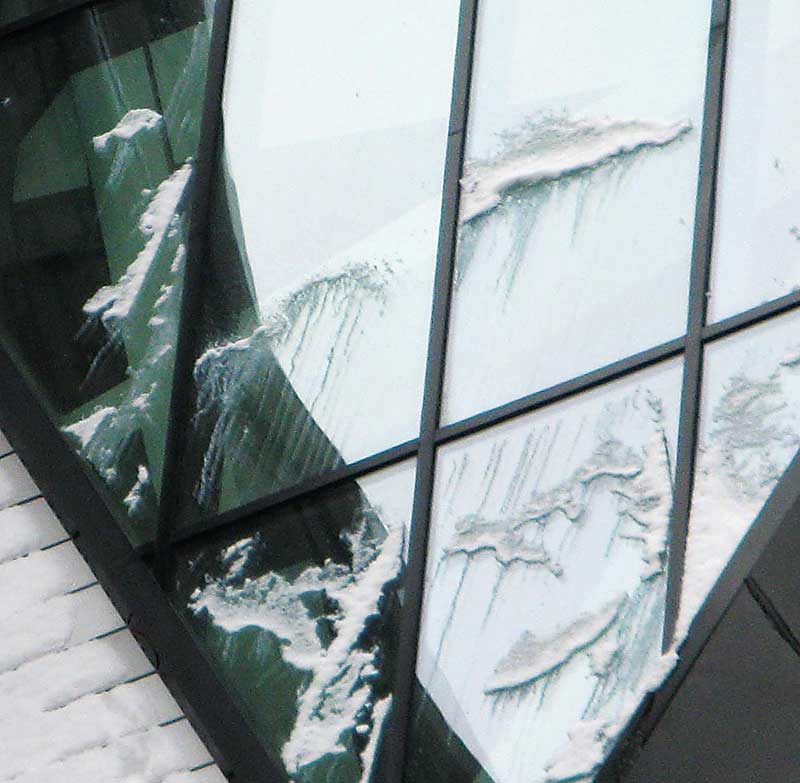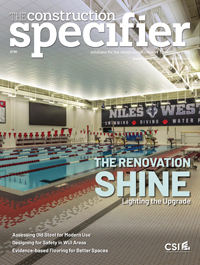Beware of falling ice and snow

What are the most common issues arising in incident reports?
Documented incidents of falling ice and snow from buildings tend to come in two distinct categories. The first, and typically most hazardous, category is that of sliding or falling ice and snow from a large sloped roof surface. These occurrences have been known to crush cars, damage buildings, and harm people.
The second category is smaller formations of hardened snow/ice or icicles that release and fall from building façades and roof edges. This category comprises many variations that can be summarized as the formation and release of multiple ice pieces or icicles, caused by:
- increased accumulation due to design features (e.g. sloped wall, double wall, rainscreen, exterior solar shades, ledges, sills, artistic features, or triple glazing); and/or
- characteristics of thermal performance that can cause the refreezing of melt water, forming ice masses, sheets, and icicles (i.e. water migration down a façade or roof that runs from warm to cold).
What types of buildings have historically experienced problematic falling ice and snow?
The answer is simple—all buildings can experience issues thanks to the variations and intensities of nature. However, large and tall buildings tend to experience more challenges strictly based on their increased size and surface area, which can contribute to bigger issues. Additionally, buildings or structures located in urban environments with limited green space around them have an increased sensitivity to an incident as falling snow or ice is more likely to impact public spaces or neighboring buildings.
Facilities with mission-critical operations—such as hospitals, airports, transportation hubs, and government buildings—can also face challenges because of their restricted access and limited tolerance to downtime. Further, for monuments or certain government projects where operations or management staff are not housed onsite, reaction time is not ideal to address winter safety issues.
What misconceptions can often mislead designers and owners?
The mitigation of falling ice and snow during the design process is not a clearly defined building code requirement. Thus, there is an erroneous notion avoidance of investigating potential issues is a way of avoiding additional risk. However, consideration of the following two situations suggests otherwise.
1. If a major issue is realized after the first couple of winters, a building can be declared unsafe in colder weather. This often leads to the realization retrofitting is typically costly and intrusive, potentially affecting the designer’s reputation. For example, a prominent building in the Washington, D.C., area was declared unsafe in winter conditions by the fire marshal, as ice and snow would fall from roof/wall surfaces blocking emergency exits.
2. There is legal precedence that adequate design includes safe building performance in both summer and winter conditions. To this point, a 2013 court ruling between a building owner and the architect’s insurer ruled the insurer should pay $3 million in damages to the owner for issues with snow and ice accumulation that would release and fall from the building’s newly completed façade.
Are there disconnects in the design process? How can a design team avoid problematic outcomes?
While there are well-established processes dealing with wind and rain on a building envelope, winter precipitation is often only addressed in a static form for snow-loading purposes. This is the first major disconnect. Winter precipitation comes in many forms that can slide, slump, drift (i.e. be redistributed by wind), melt, and transform, refreezing into ice sheets, layered masses, and icicles. This complexity of winter precipitation’s ‘life cycle’ on a building roof or wall is rarely sufficiently understood or investigated through established evaluation procedures.
To address this disconnect and others, here are some considerations for one’s next design project:
1. If the building (existing or proposed) has large sloped roof surfaces, complex roof shapes, or adjacent building geometry to roof surfaces, the formation of winter precipitation should be considered as potentially dynamic in addition to the typical static (i.e. it can move, behave, and transform in ways the typical suggested building code load cases do not describe in detail).
2. Steeply sloped wall surfaces (i.e. a surface steeper than 70 degrees) are generally not considered from a structural snow- or ice-load perspective. However, this does not mean ice and snow do not collect; they still have the potential to be hazardous from a serviceability viewpoint (e.g. release as falling snow, ice, or icicles).
3. Development of a design directive or criteria from ownership regarding its tolerance for relying on operational procedures with respect to maintaining the building and surrounding site in winter is rarely discussed or established. (Unless, of course, a previous incident has occurred on a decision-maker’s watch.) One should consider the acceptability of temporary restricted access, the need for falling ice signs, and the requirement to monitor and clear building surfaces. If these items are to be avoided, then a true evaluation of the risks should be considered.
In fact, the New York City Department of Buildings routinely sends out advisories stating if a snow or ice condition develops that poses an imminent hazard to the public, building owners and construction site managers should immediately take precautions to protect the surrounding area, including cordoning off any area where snow or ice are falling. The department also suggests consulting a professional to advise how to secure construction sites and buildings if necessary.
4. Heat-trace or ice and snow retention devices are often thought of as commercial products designed to address ice and snow problems in general. However, the truth is many of these products are designed for the residential market, or to address specialized applications. Their use and integration in large-scale design projects requires expert knowledge and planning. Consequently, these products have gained a reputation to often fail, underperform, or cause unintended consequences that become problematic on larger-scale projects.
5. There is little to no regulation or standards governing the ice and snow retention industry. This also applies to the mitigation of falling or sliding ice and snow from buildings and structures in general. In other words, it is buyer beware.



